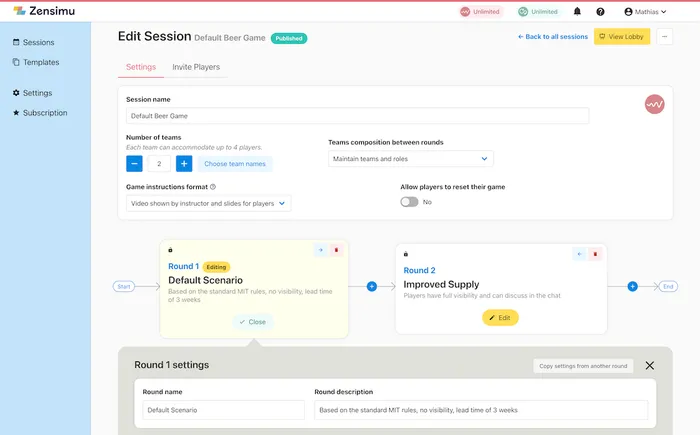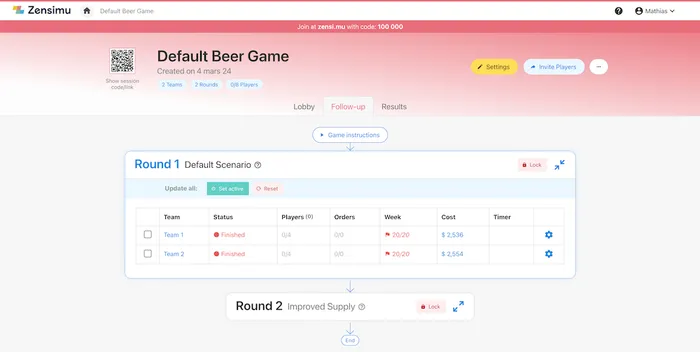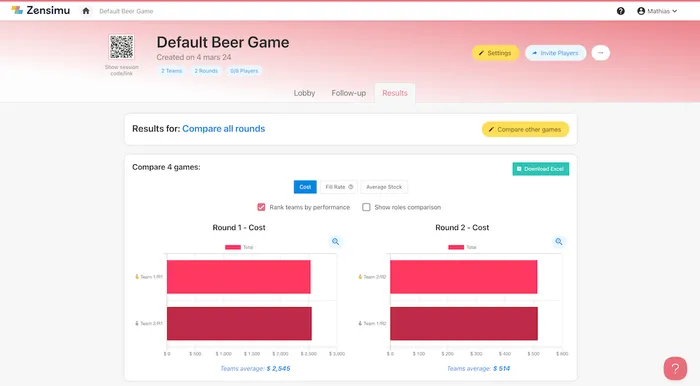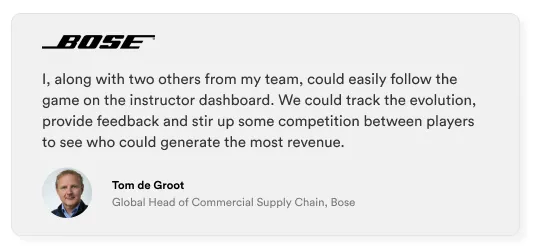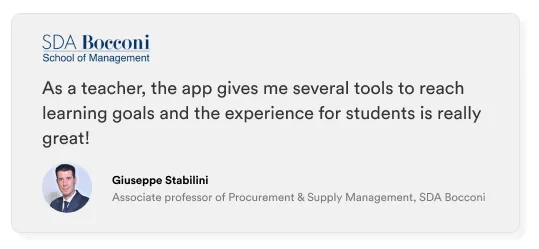In the realm of supply chain management, few learning tools have garnered as much attention—or yielded as many valuable insights—as the beer game.
Originally conceptualized at MIT, this interactive simulation continues to help students, professionals, and businesses alike understand the intricate workings of supply chains.
Designed to highlight critical challenges such as the bullwhip effect, delayed communication, and strategic coordination, the beer distribution game provides a hands-on environment for grasping concepts that are often difficult to observe in real-life operations.
In this comprehensive guide, we will delve into every facet of the beer game in supply chain:
- Its historical origins, fundamental objectives and key lessons,
- How the Beer game is played, both in traditional classroom settings and in modern online formats,
- A comparison of the classic board-based version vs the digital Beer Game ;
- Various use cases of the Beer Game: online seminar, workshop, class, onboarding, businesses, consulting firms, schools ;
- Practical tips for hosting, animating, and debriefing a Beer Game session ;
- The leading Beer Game simulations, including Zensimu’s solution
Whether you’re a seasoned supply chain professional looking to coach or onboard your team, an educator seeking an engaging teaching method, or a curious learner eager to deepen your understanding of complex supply chain phenomena, this guide will equip you with everything you need to master the beer game supply chain. Let’s get started.
What is the Beer Game?
The beer game, also known as the beer distribution game, or supply chain management beer game, is a role-playing simulation that illustrates the complexities, challenges, and nuances of managing a supply chain.
Originally developed at the MIT Sloan School of Management in the 1960s, it has stood the test of time, helping countless students, professionals, and organizations grasp the fundamentals of supply chain dynamics — most notably the bullwhip effect.
The simulation is centered on a multi-tiered supply chain scenario of retailer, wholesaler, distributor, and factory. The simplicity of managing just one product—beer—masks underlying complexities like the bullwhip effect and the importance of timely information sharing.

While the premise seems straightforward, the underlying theory reveals how small fluctuations in demand can cause increasingly larger swings in inventory and orders upstream in the supply chain.
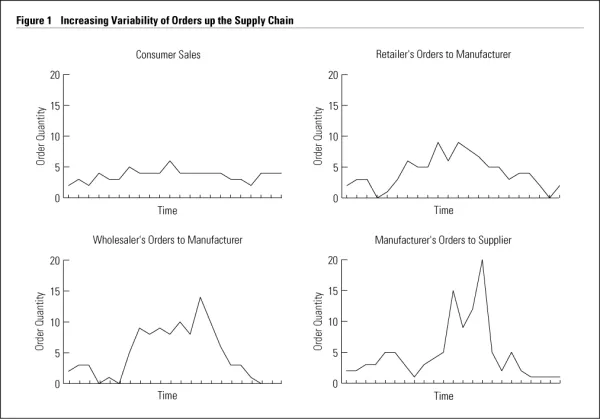
The game, therefore, acts as a springboard for discussions about communication, coordination, and strategic decision-making, showcasing how information delays and siloed thinking can lead to inefficiencies and costly mistakes.
History of the Beer Game
The MIT beer distribution game originated as a classroom exercise at the Massachusetts Institute of Technology in the early 1960s. Created by Jay Forrester and his colleagues, the game quickly spread to universities and training programs worldwide.


Over the decades, it has evolved from a simple board-based activity into more sophisticated forms, including beer game simulations online. Today, online beer games and digital platforms—such as those offered by Zensimu—allow for global participation, real-time data analytics, and the opportunity to run multiple iterations rapidly.
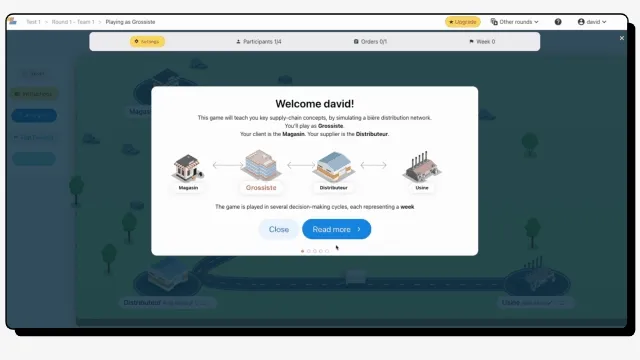
What is the Objective of the Beer Game?
The fundamental objective of the beer simulation game is to minimize total supply chain costs—often represented by inventory holding and backorder costs—by managing orders effectively. Each player aims to balance the often-competing priorities of having enough stock to meet demand without holding excessive, costly inventory.

By the end of a beer distribution game simulation, participants learn that achieving optimal supply chain performance is not about local optimization but about cohesive, system-wide strategy.
Who Can Benefit from the Beer Game?
The beer game supply chain simulation benefits a wide array of participants and settings, as illustrated by various real-world examples:
- Business Professionals: Managers, supply chain planners, and procurement specialists use the beer distribution game in team-building activities, onboarding programs, and strategy sessions to illustrate demand fluctuations, inventory management, and communication challenges. Bose leveraged the Beer Game during its online sales seminar to gain critical insights and improve their supply chain operations.
- Consultants and Agencies: Consulting firms integrate the beer game solution into workshops, and corporate training events to demonstrate the impact of different policies and strategies on supply chain performance for their clients. The Mews Partners case study showcases how a consulting firm effectively utilized the Beer Game to optimize their training sessions and deliver measurable value to clients.
- Students and Educators: Universities and business schools employ the MIT beer game as a practical teaching tool, including live classroom simulations, online sessions, and academic workshops, to illustrate core supply chain concepts and improve students’ decision-making skills. The Bocconi case study highlights how an academic institution successfully integrated the Beer Game in a large online contests to enhance learning outcomes and student engagement.
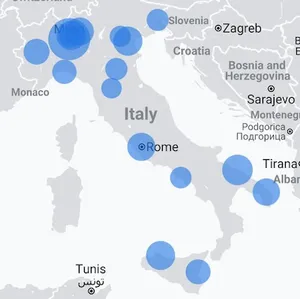
Long-Term Benefits of the Beer Game
The lessons learned from the Beer Game go far beyond the immediate experience:
- Cost Reduction: Participants learn to balance inventory levels, minimizing excess costs due to stockouts or overages.
- Improved Information Flows: The simulation highlights the importance of quick and accurate communication across the supply chain.
- Adoption of Systems Thinking: Players understand that local decisions impact the entire system.
- Enhanced Resilience: Simulated scenarios prepare teams to better respond to real-world disruptions.
3 Learnings of the Beer Game
By immersing players in realistic scenarios, the Beer Game highlights key challenges like the bullwhip effect, the importance of information flow, and the impact of lead times. Below, we present five essential lessons that consistently emerge from the Beer Game experience.
The Bullwhip Effect
The bullwhip effect is a classic phenomenon in supply chain management, prominently showcased within the Beer Game. It occurs when even minor fluctuations in customer demand at the retail level grow disproportionately larger as you move upstream through the wholesaler, distributor, and ultimately the factory. Initially insignificant changes can escalate into significant order volatility, causing overstocking, stockouts, and increased operational costs.
Within the Beer Game setting, players quickly see how a small miscalculation or delay in information flows can create outsized, 'whip-like' swings in inventory and orders. Rather than serving as a simple exercise, this dynamic simulation demonstrates the critical importance of clear communication, stable ordering policies, and system-wide thinking.
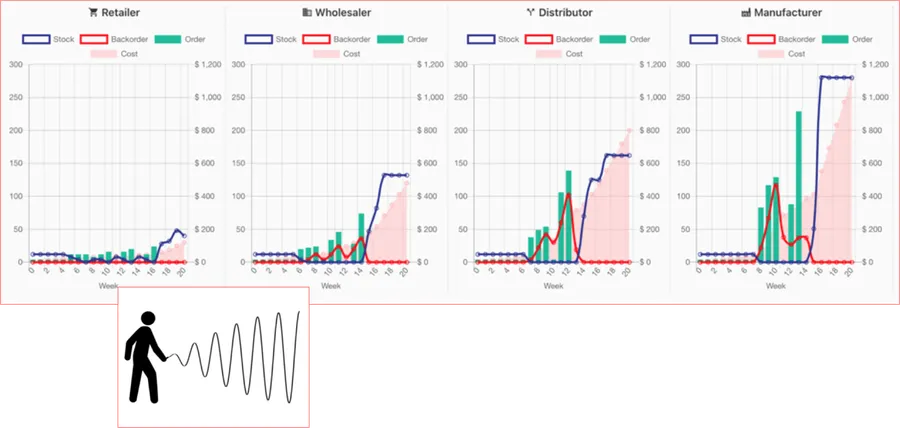
For a deeper understanding, you can visit Zensimu’s bullwhip effect guide.
Lead Times and their impact
In the Beer Game, lead time refers to the delay between when an order is placed and when it is fulfilled. This includes the time it takes for the supplier to process the order, pack the goods, and ship them, as well as the transit time until the product arrives at your location.
The Beer Game effectively demonstrates how these time delays affect inventory levels, order quantities, and overall decision-making.
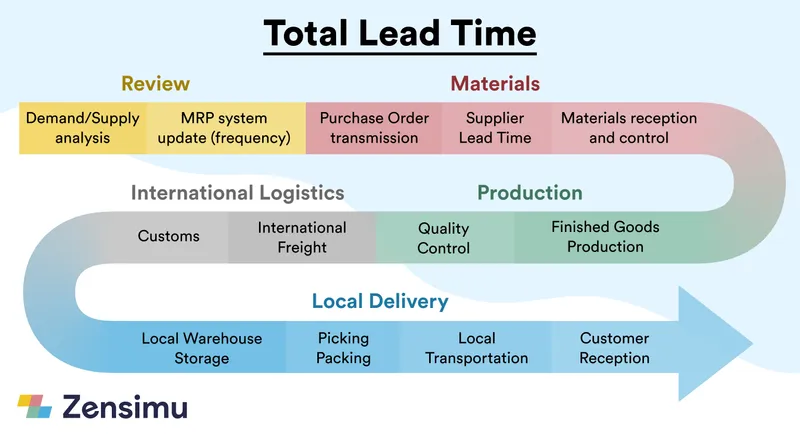
When players face longer lead times, they must forecast demand further into the future. A misalignment between current demand signals and projected needs can easily result in over-ordering or under-ordering. This, in turn, contributes to the bullwhip effect—small fluctuations in demand become amplified due to the lag in receiving new inventory. Longer lead times generally increase uncertainty, making it harder to accurately judge how much to order at any given time, especially if demand patterns are volatile or if communication within the supply chain is limited.
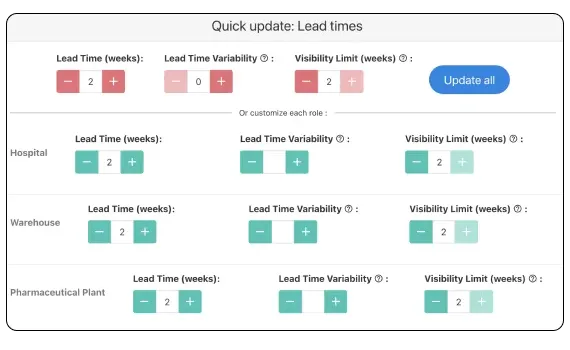
By exploring different scenarios within the Beer Game, participants gain firsthand insight into how changing lead times can influence their strategies and outcomes. They quickly learn that reducing lead times, or at least better understanding and managing them, can stabilize the supply chain.
Importance of Collaboration and Communication
In any supply chain, timely and accurate information flow is crucial for making informed decisions. The Beer Game highlights how even small delays or inaccuracies in communicating demand, inventory levels, or shipment statuses can lead to misalignment and costly inefficiencies.
When one player in the chain receives outdated or incomplete information, they are more likely to overestimate shortages or surpluses. This reactive behavior often results in larger order fluctuations, higher inventory carrying costs, or stockouts—all manifestations of the bullwhip effect.
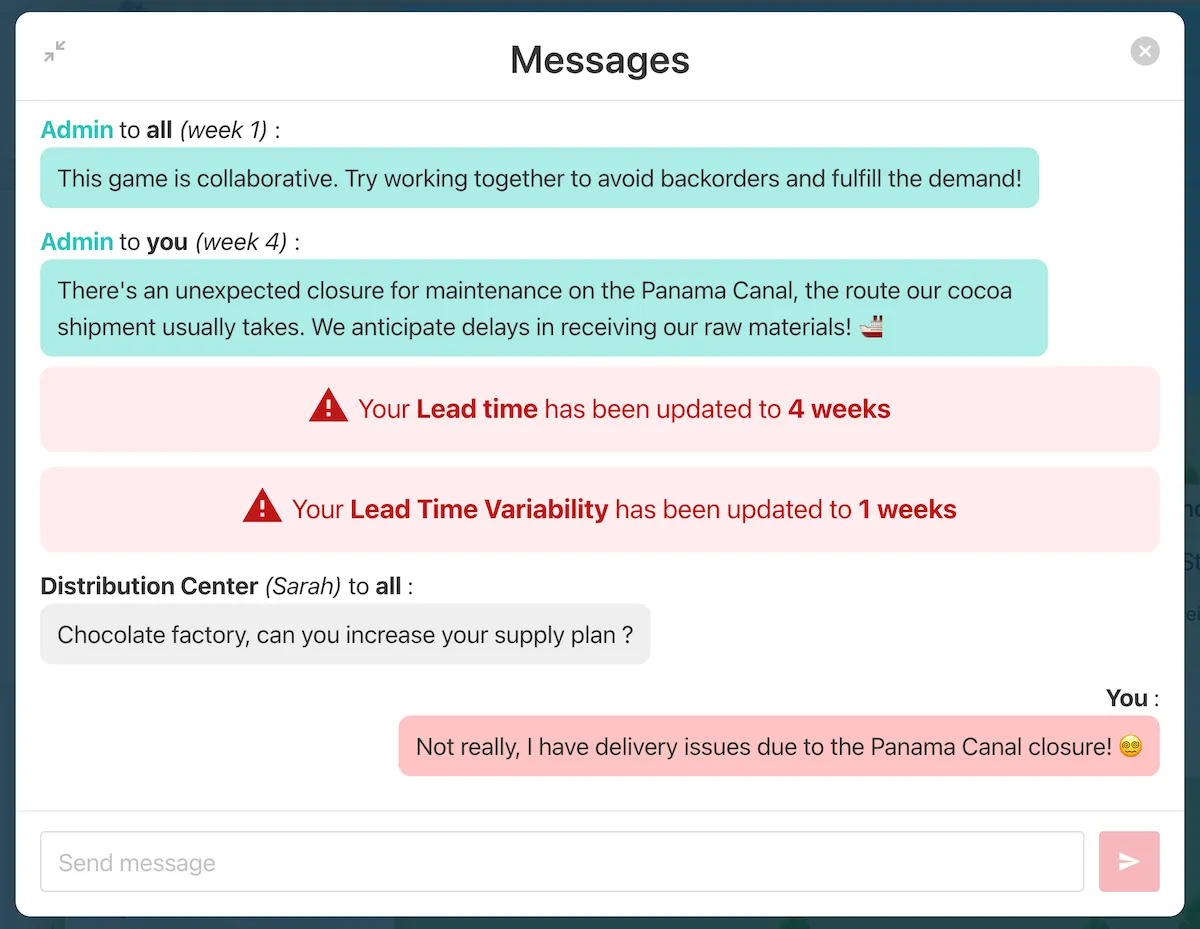
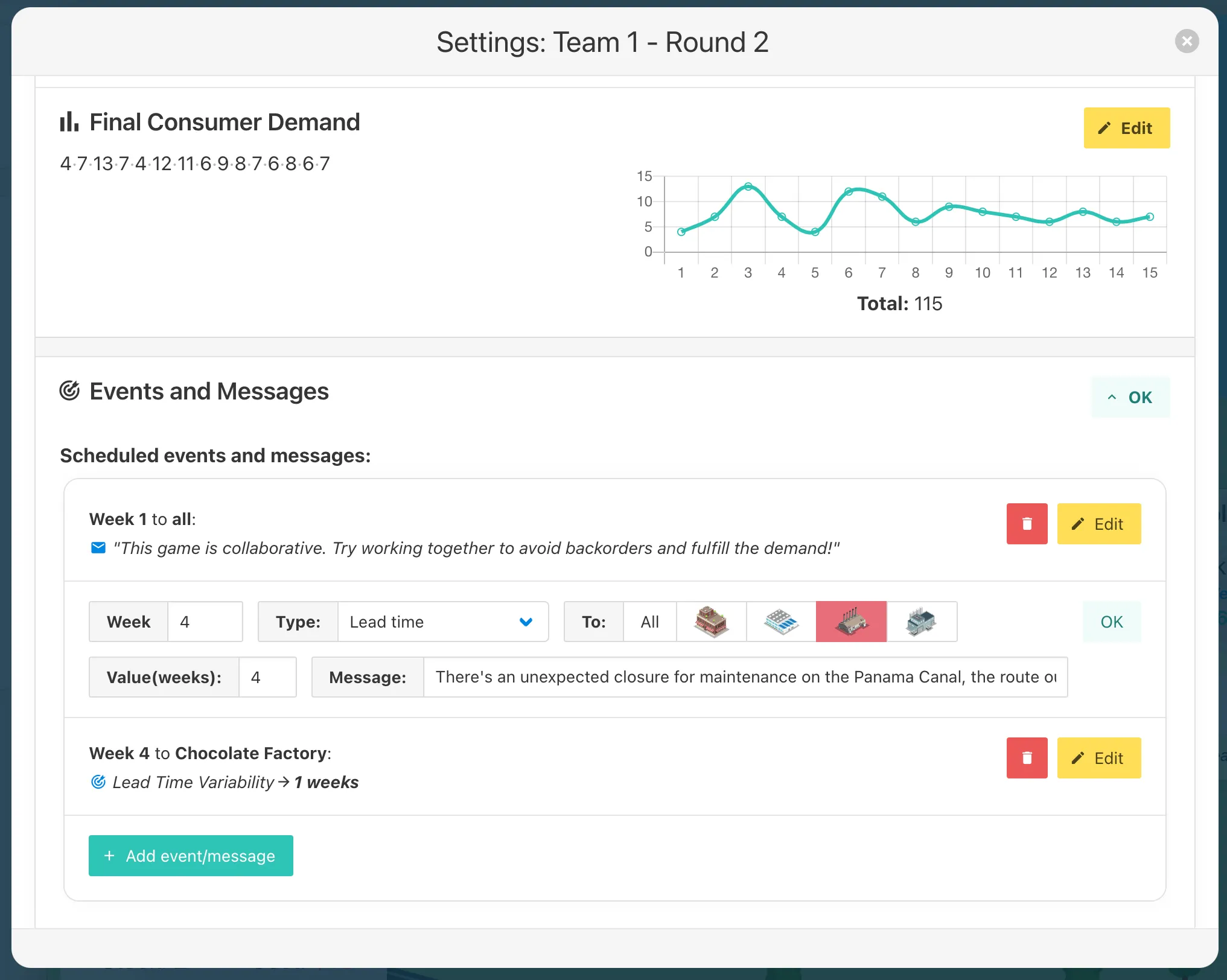
Zensimu emphasizes the value of teamwork and transparent communication within supply chains through several key features:
- Transparent Mode: Participants can see each other’s inventory and production plans, mimicking a shared ERP system and encouraging more informed decision-making.
- Real-Time Chat: Teams communicate instantly, discussing strategies, negotiating adjustments, and coordinating responses as situations evolve.
- Automated Alerts: Players receive immediate notifications about stock shortages or backorders, prompting collective action to reduce costly delays.
Improving information flow involves not only faster communication but also clearer, more consistent data sharing. For instance, the concept of Just-In-Time (JIT) manufacturing emphasizes maintaining minimal inventory and responding quickly to actual demand signals rather than forecasts. JIT relies heavily on accurate and immediate information so that production aligns closely with consumption, reducing waste and excess holding costs.
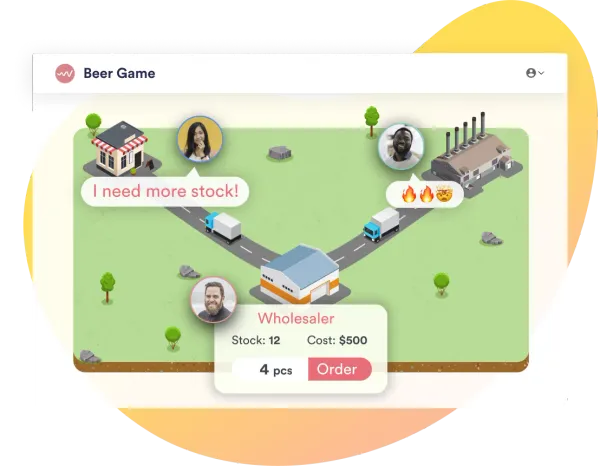
If you’re interested in exploring more key lessons and insights drawn from the Beer Game, be sure to check out this in-depth article on the BeerGame App and Key Lessons. It provides additional perspectives, strategies, and best practices that will help deepen your understanding and improve your overall supply chain management approach.
With these key lessons in mind, let’s now turn our attention to the practical side of things and explore How Does the Beer Game Simulation Work? This will help you understand the step-by-step process of playing the game and applying these insights in a hands-on environment.
How Does the Beer Game Simulation Work?
How to Play the Beer Game
In the classic beer game, four roles represent tiers of the supply chain:
- Retailer: Directly faces customer demand.
- Wholesaler: Buys from the distributor and sells to the retailer.
- Distributor: Purchases from the factory and distributes to wholesaler.
- Factory: Produces beer and supplies the distributor.
To get a clearer picture of the Beer Game in action and better understand the sequence of decisions and reactions throughout each round, our tutorial video walks you through the game’s mechanics step-by-step, helping both newcomers and experienced professionals understand the rules and refine their strategies.
Players receive weekly orders and must decide how much to order from their immediate upstream supplier.
Each stage:
- Has its own stock of beer cases,
- Has a supplier from which it receives beer cases - and to which it places orders,
- Has a client from which it receives orders (= demand) - and to which it ships beer cases
- The Retailer's client is the end-consumer, played automatically by the computer. The manufacturer doesn't have a supplier but produces beer cases internally.

Their choices affect inventory levels, backlogs, and costs. The winner is the team or individual that achieves the lowest cumulative cost. Here is an example of a Beer Game session Results Page:

Debriefing After the Game
Once the simulation is complete, a debriefing session is held to analyze performance and draw lessons learned. Participants review the overall results, including:
- The total costs of the supply chain.
- Fluctuations in inventory and orders.
- The causes of inefficiencies, such as the bullwhip effect or communication delays.
How Do You Play the Beer Game in Class?
When played in a classroom setting, the beer game simulation often begins with a brief introduction from the instructor, followed by assigning roles and distributing materials such as game boards, tokens (representing beer cases), and record sheets.
Students rotate turns, placing orders and receiving shipments. The instructor tracks costs and leads a debrief session afterward, highlighting key insights about supply chain management and decision-making.
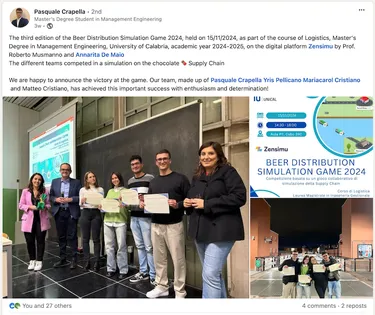

How Do You Win the Beer Simulation Game?
Winning strategies usually involve:
- Stabilizing Orders: Avoid overreacting to short-term demand fluctuations.
- Better Communication: Share demand and inventory data transparently.
- Consistent Policies: Adhere to a sound ordering strategy that factors in lead times and avoids panic adjustments.
- Focus on the Big Picture: Resist the temptation to prioritize local optimization. Instead, consider the health of the entire supply chain.
Players assume roles in a supply chain and make ordering decisions weekly.
Board Beer Game vs. Online Beer Game
The traditional board beer game uses physical tokens, cards, and boards. It’s tactile and interactive, often played in person. However, a beer distribution game online offers several advantages:
- Real-Time Analytics: Online versions track inventories, orders, and costs automatically, providing instant feedback.
- Scalability: Host large groups and remote participants easily.
- Accessibility: No need for physical materials. Participants can join from anywhere worldwide.
- Speed and Iterations: Faster setup times and the ability to run multiple simulations improve learning outcomes.
We’ve created a comprehensive comparison article who’ll show you the differences between the traditional, physical board setup of the Beer Game and its modern online counterparts.
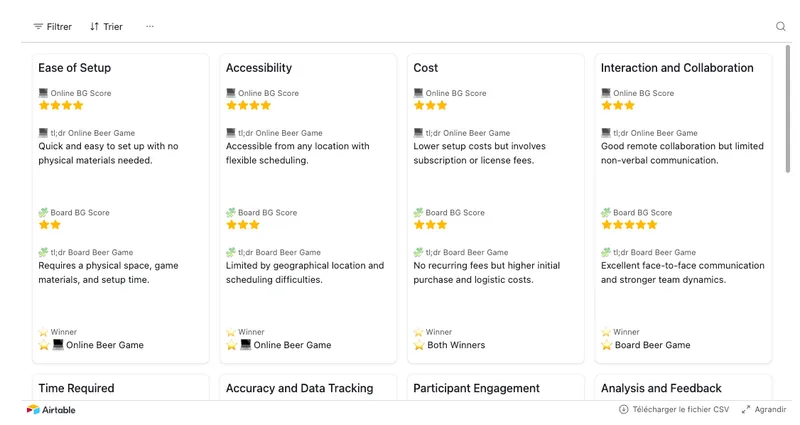
Zensimu's hybrid Beer Game Simulation combines the strengths of both formats, providing a comprehensive solution that maximizes engagement, efficiency, and adaptability.
By examining each format’s strengths and limitations, you’ll be able to determine which approach best fits their teaching or training objectives.
What are the Materials needed for the Beer Game Supply Chain?
For the board version, you typically need:
- A game board or printed layout representing each tier.
- Tokens or chips to represent beer inventory.
- Order slips or cards for placing orders.
- Record sheets (or individual computers with Excel spreadsheets) to track inventory, orders, and costs.
Online beer simulation games eliminate these physical needs, replacing them with digital interfaces and dashboards.
Main Beer Game Use Cases
Beer Game for Businesses
For businesses & Manufacturing companies, the Beer Game serves as an interactive training tool that immerses teams in the complexities of supply chain management. Here are some use cases:
- Employee Training and Engagement: The Beer Game help employees develop essential problem-solving and decision-making skills within a supportive, team-oriented environment. Incorporating the Beer Game into onboarding sessions, sales and marketing workshops, or continuous improvement programs nurtures a more dynamic and engaged workforce.
- Supply Chain Optimization & Waste Reduction: The Bose example illustrates how companies can use simulation games like the Beer Game to improve operational efficiency. By gaining a deeper understanding of supply chain complexities, managers can identify inefficiencies, reduce process waste, and implement strategies that ultimately cut costs and enhance overall performance.
- Fostering Collaboration and Teamwork: The Beer Game’s interactive format promotes trust, synergy, and better group problem-solving capabilities, making it ideal for team-building events, corporate seminars, and workshops designed to strengthen organizational cohesion.
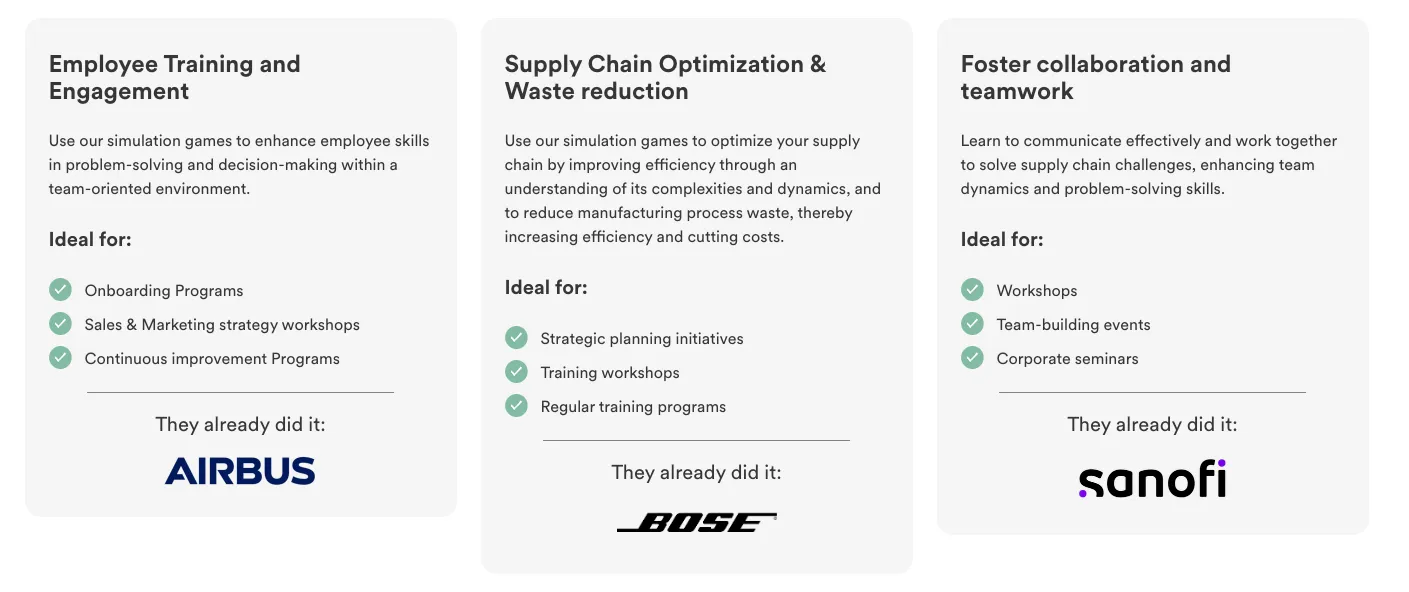
Beer Game for Online Seminars: Bose Case Study
A notable example of how the Beer Game can help organizations refine their practices comes from Bose, a leading audio equipment manufacturer. As detailed in the Bose Case Study, the company integrated the Beer Game into its Online Seminar to expose managers to the ripple effects of everyday decisions. This hands-on experience allowed Bose’s team to identify bottlenecks, reduce inventory fluctuations, and streamline their ordering processes. Ultimately, the insights gained through the simulation translated into tangible improvements—lower operating costs, more stable supply chains, and a more proactive approach to managing demand variability.
Beer Game for Consulting Firms
Consulting firms often operate at the intersection of strategy, training, and practical implementation. By integrating the beer distribution game simulation into their service offerings, these firms can transform theoretical discussions into tangible learning experiences.
- Onboarding Programs: Introduce new team members to complex operations in a controlled, low-risk environment.
- Strategic Planning Workshops: Use the Beer Game’s iterative rounds to help leadership teams understand the impact of long-term decisions.
- Regular Training Programs: Reinforce lessons learned over time, gradually developing internal best practices.
Mews Partner Example
Mews Partners, an independent management consulting firm, leveraged Zensimu’s Beer Game to optimize project kickoffs and consultant skill-building initiatives. Previously, Mews Partners used manual methods (Excel spreadsheets and Post-its) to run the Beer Game, which limited their ability to scale and host sessions for larger groups—particularly in remote or hybrid environments.
By adopting Zensimu’s online Beer Game platform, Mews Partners achieved a more modern, customizable, and automated approach. This switch not only saved time but also allowed them to engage more participants simultaneously, regardless of geographic location, and boosted the firm’s professional image and opened new avenues for conversation with clients.
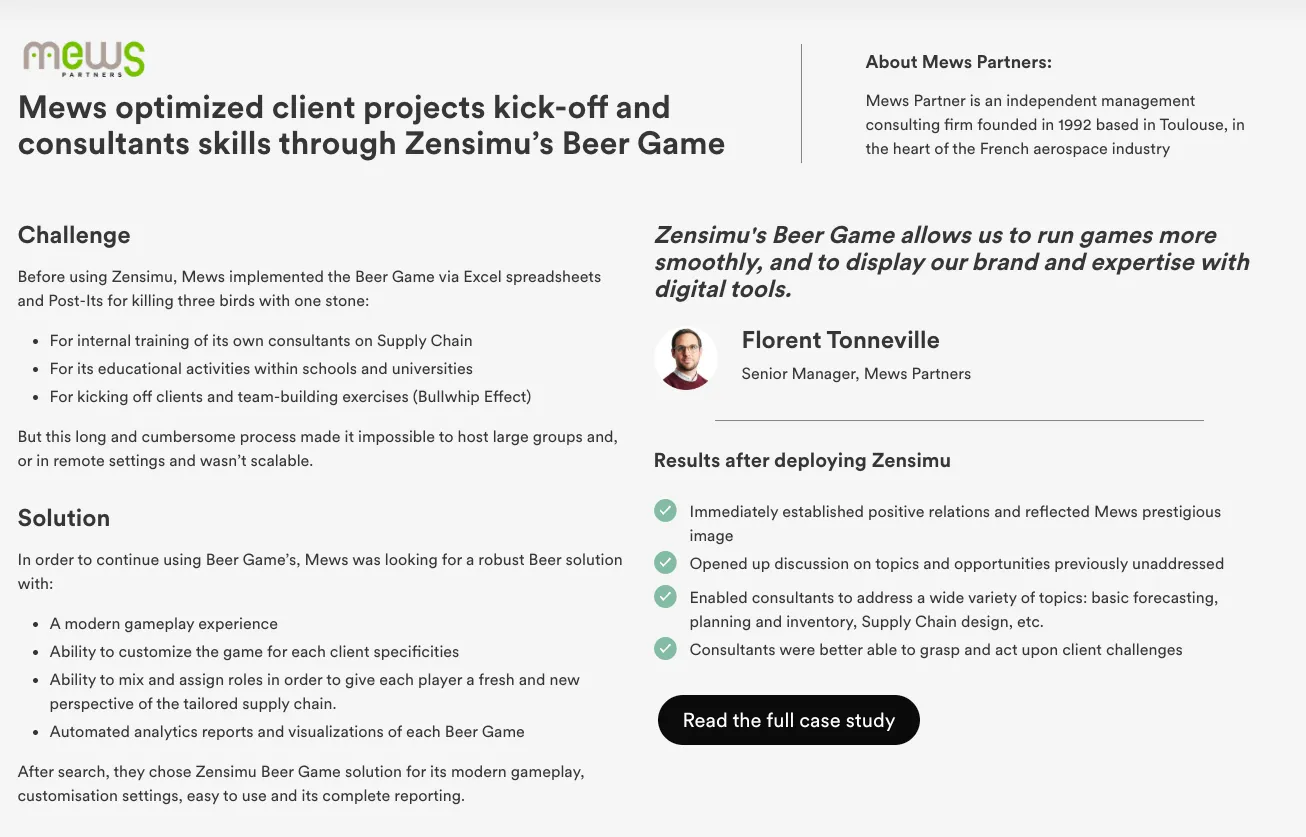
Beer Game for Schools
Educational institutions, including universities and business schools, leverage the MIT beer game to provide students with an interactive, hands-on approach to understanding supply chain dynamics. Instead of solely relying on lectures or textbooks, professors integrate the Beer Game into their courses—spanning operations management, supply chain, and broader business curricula—to make learning more engaging and practical.
A prime illustration of the Beer Game’s educational impact is seen at Bocconi University in Milan. A renowned institution offering degrees in economics, finance, law, and management, Bocconi sought a scalable, immersive simulation that could engage hundreds of students simultaneously across various departments and campuses.
SDA Bocconi Example
By deploying Zensimu’s Beer Game solution, Bocconi was able to:
- Create a Large-Scale Contest: Over 500 students participated, bridging multiple programs and campuses.
- Enhance Engagement and Understanding: Students significantly improved their grasp of supply chain dynamics.
- Streamline Instructor Effort: Automated debriefing tools and clear metrics helped pinpoint areas of improvement.
- Deliver Memorable Learning Experiences: A competitive spirit made supply chain learning more enjoyable.
How to Master the Organisation of a Beer Game session?
If are ready to create your first Beer Game session, you need to read our complete instructor guide. This guide equips instructors with a clear framework to prepare, facilitate, and debrief the Beer Game in both educational and corporate settings.
- Set Learning Goals: Identify the skills and insights you want participants to gain (e.g., inventory management, understanding the bullwhip effect).
- Select the Format: Decide between a physical board setup or an online version. Prepare necessary materials or set up the digital platform.
- Brief Participants: Explain the rules, roles, expectations, and timing. Provide written instructions and assign roles before starting.
The Beer Game scenario Builder lets you customize every detail of your simulation before it begins—tweak lead times, starting inventories, demand patterns, and cost structures to create scenarios that reflect real-world challenges or specific learning goals. It offers a streamlined, time-saving way to tailor each session’s complexity, focus on particular supply chain issues, and engage participants with conditions that suit their expertise level.
2. Running an engaging Beer Game Session
- Start the Game: Assign each participant a specific role—retailer, wholesaler, distributor, or factory—and make sure they understand the basic flow of orders, deliveries, and inventory management.
- Manage Time: Keep each round moving at a steady pace. This helps participants stay focused and encourages quick decision-making.
- Encourage Communication: Prompt meaningful discussions and collaborative problem-solving, replicating real-world supply chain conversations.
If you’re hosting a large Beer Game session, we’ve created a complete guide to help you.
3. Conducting an efficient debriefing session
- Reflect on the Experience: Encourage participants to openly discuss their challenges, successes, and key takeaways.
- Analyze Results: Highlight how decisions, delays, and limited information contribute to fluctuations in the supply chain.
- Apply to Real-World Context: Draw direct parallels between in-game actions and real-world supply chain scenarios.
For a complete Debriefing report, read our Instructor Guide dedicated to conduct a Post Beer Game debriefing session.
4. Post-Session Follow-Up
- Provide Additional Resources: Use the debriefing report to identify areas needing further development, then offer targeted readings or case studies.
- Encourage Application: Show participants how data and insights captured in the debriefing report can guide future decisions.
For best practices, consult the debriefing instructor guide.
The Best Online Beer Games Tools
1. Zensimu: a modern, online multiplayer simulation designed to teach supply chain principles interactively. Players work together in real-time, from any device. Its focus on user-friendliness, detailed analytics, and adaptability makes it a preferred choice for companies and universities aiming to highlight the bullwhip effect and foster collaboration in diverse teams.
Our dear customers have crowned Zensimu as one of the best Beer Game tools out there. We spend a lot of time delivering intuitive interfaces, real-time analytics, and customizable scenarios that can mimic anything from a smooth-as-butter supply chain to a chaotic mess of guesswork and heartbreak.
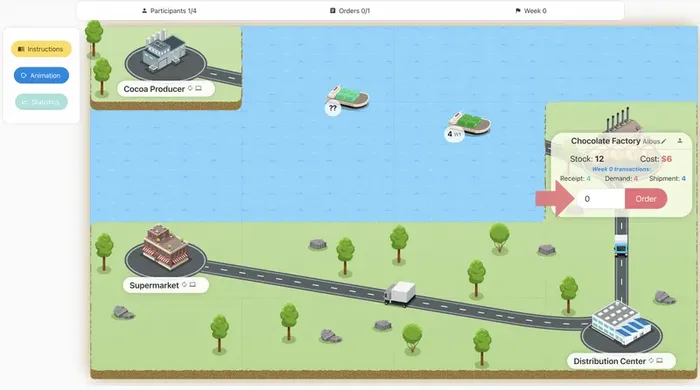
2. Harvard Business Publishing Education: Root Beer Game: a well-established simulation grounded in academic rigor. It emphasizes a more traditional approach to supply chain teaching, leveraging its longstanding reputation and structured scenarios.
Its strengths include a polished interface and the credibility of the Harvard brand, along with integration into broader learning modules. However, it may feel less dynamic compared to Zensimu’s real-time multiplayer engagement. Additionally, its higher pricing (around twice as expensive as Zensimu - for both universities and companies) can be a constraint for teams with limited budgets, making it less accessible to smaller organizations.
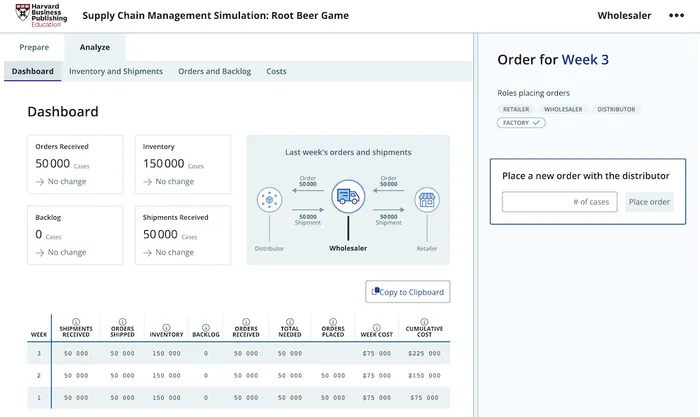
3. Free Beer Game versions: an accessible entry point for understanding how the game works. However, their limitations are notable. They often lack multiplayer functionality, which is essential to replicate group and collaborative dynamics. The instructor views are also minimal or non-existent, without a proper dashboard to monitor and compare teams. As a result, they fall short for professional or academic settings requiring deeper engagement and durable learning outcomes.
If you are just getting started, Zensimu provides a free single-player demo, you can try it here.
Presentation of the Beer Game by Zensimu
Zensimu offers a comprehensive Beer Game self-service tool, designed for Businesses, Universities and consulting firms, in both online and physical environments.
You start by crafting a scenario that matches your objectives, engage participants in a dynamic and data-driven environment, and then transform the results into tangible strategies for real-world supply chain enhancements. This structured method ensures that participants not only enjoy the simulation but also walk away with insights they can apply immediately in their day-to-day operations.
1. Set up Your Scenario
This is where you (optionally) tailor the Beer Game to suit your learning objectives. The Beer Game Scenario Builder gives you the flexibility to:
- Adjust Key Parameters: Decide how many rounds to run, how long each round lasts, and the overall complexity you want participants to experience.
- Brand Integration: Customize the simulation’s interface with your company’s logo and color scheme.
- Pre-Made Templates and Incremental Complexity: Start with simpler scenarios and progressively introduce new elements such as demand variability or cost adjustments.
2. Invite and Play!
In the second step, you can seamlessly bring in participants, ranging from just a few individuals up to hundreds, to engage in the simulation:
- Scalability: Whether you’re running a small workshop or a large-scale training event with up to 600 participants, the platform can handle the load.
- Self-Paced Onboarding: Each participant can access instructions and game rules directly in the interface.
- Real-Time Interaction & Analytics: A built-in chat feature promotes communication and coordination among team members.
3. Debrief & Analyze
The Debriefing reporting turns a fun, interactive game into a meaningful learning experience:
- Automated Reports and Visualizations: Immediately following the session, you receive clear charts, graphs, and performance metrics.
- Comparative Analysis: Examine results across different teams, roles, and rounds for valuable strategic discussion.
- Data Export Options: Export data in PDF, PPT, or Excel formats to present findings or integrate insights into ongoing projects.
- Actionable Takeaways: The debriefing process ensures that lessons learned are translated into practical improvements.
Why is Zensimu the leader for Beer Game Simulations hosting?
Zensimu is not just another simulation tool—it’s a fully integrated solution that delivers immersive learning, adapts to diverse training needs, and offers robust analytical capabilities. Its combination of flexibility, ease of use, detailed analytics, and strong customer endorsements sets it apart from the competition. By choosing Zensimu, organizations gain a dynamic, scalable, and value-driven tool that turns theoretical lessons into practical, actionable outcomes.
1. An Immersive Learning Experience
Zensimu’s simulation tools use engaging visuals, animations, and interactive scenarios that go beyond static presentations. Instead of passively absorbing theory, participants become active players in a dynamic environment—leading to deeper understanding, stronger retention, and more practical insights.
2. Exceptional Reputation and High Satisfaction Ratings
Zensimu’s clients, ranging from large multinational firms to prestigious universities, consistently rate the platform highly. This positive feedback is a testament to the solution’s effectiveness and reliability, demonstrating real-world impact rather than just promising it.
3. Flexible, Usage-Based Pricing
Zensimu breaks free from rigid pricing models. With subscription options that let you run multiple training rounds on your terms, organizations can scale usage to match their learning objectives. Universities, corporations, and training institutes all benefit from this cost-effective approach.
4. Multiple Arrangement Possibilities (Online, Hybrid, In-Person)
Unlike many solutions that are limited to a single format, Zensimu accommodates a variety of setups—online, physical, or hybrid. Whether you’re hosting a global remote team session or a local hands-on workshop, the platform adapts, providing consistent quality across different training environments.
5. Quick, Error-Proof Setup
What once took hours or days to prepare can now be handled in a fraction of the time. Zensimu’s user-friendly interfaces and automated processes reduce complexity, minimize the risk of errors, and save significant effort. Instructors can focus on facilitating learning rather than managing complicated logistics.
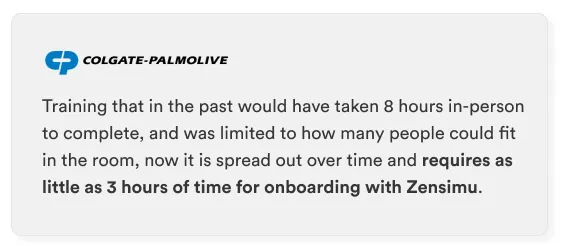
6. A Complete Scenario Builder
Zensimu’s scenario customization tools allow instructors to design training sessions that perfectly mirror real-world challenges. Adjust demand patterns, lead times, or market conditions—no one-size-fits-all scenario is forced on you. This flexibility ensures that the learning experience is always relevant and impactful.
7. Designed for Self-Service
There’s no need to hire external consultants or pay extra fees just to get started. Zensimu’s platform is intuitive enough to let instructors and training managers run simulations independently. This autonomy empowers organizations to incorporate the game into their programs swiftly and cost-effectively.
8. Comprehensive Post-Game Analytics
Zensimu provides immediate, in-depth analytics once the simulation ends, including automated charts, detailed reports, and data export capabilities (PDF, PPT, Excel). Facilitators can quickly identify where teams excelled, where they struggled, and which strategies proved effective. These insights help translate in-game decisions into real-world improvements and strategic adjustments.

Conclusion
The beer game and its modern online adaptations serve as powerful tools in understanding supply chain dynamics. Whether you are a student, a business professional, a consultant, or an educator, the beer simulation game can unveil valuable lessons about coordination, communication, and strategic decision-making. By immersing participants in a controlled environment, the MIT beer game and its successors highlight the bullwhip effect and the importance of system-wide thinking.
Zensimu’s beer distribution game simulation takes these learnings a step further, offering an accessible, data-driven, and scalable platform. By choosing an online solution like Zensimu, organizations and individuals can level up their supply chain skills, reduce the learning curve, and gain actionable insights that drive real-world improvements.
